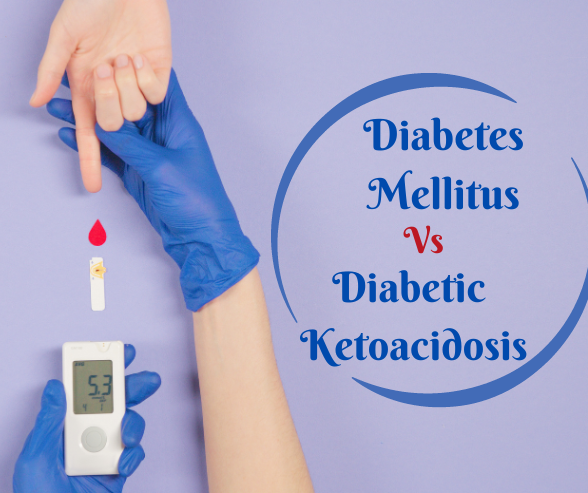Diabetes mellitus, commonly known as diabetes, is a chronic condition that affects millions of people worldwide. It occurs when our bodies can’t manage the sugar in our blood properly. There are two main types of diabetes: Type 1 and Type 2. Now, let’s talk about a serious complication related to diabetes called diabetic ketoacidosis, or DKA. In this blog, we will delve into what it means & cause of diabetic ketoacidosis, DKA symptoms , and the crucial aspect of treating Diabetic Ketoacidosis (DKA).
Diabetes Mellitus:
It is a metabolic disorder characterized by elevated blood glucose levels. The body’s inability to produce enough insulin or effectively use the insulin it produces leads to this condition. Insulin, a hormone produced by the pancreas, helps cells absorb glucose from the bloodstream for energy.
There are two primary types: Type 1 and Type 2. Type 1 diabetes results from the immune system attacking and destroying insulin-producing cells, while Type 2 diabetes occurs when the body doesn’t use insulin properly, often due to lifestyle factors.

Diabetic Ketoacidosis (DKA):
It is a severe and potentially life-threatening complication of diabetes mellitus, typically associated with Type 1 diabetes. It occurs when the body starts breaking down fat for energy in the absence of sufficient insulin. This process produces ketones, acidic substances that can build up in the bloodstream, leading to a dangerous condition known as ketoacidosis.
Causes of Diabetic Ketoacidosis:
It is primarily triggered by a shortage of insulin, commonly due to:
- Undiagnosed or untreated diabetes: People unaware of their diabetic condition may experience DKA as their bodies lack the necessary insulin.
- Inadequate insulin dosage: Insufficient insulin administration, especially in individuals with Type 1 diabetes, can lead to DKA.
- Illness or infection: Infections, such as urinary tract infections or respiratory infections, can raise stress hormones, increasing blood sugar levels and contributing to DKA.
Diabetic Ketoacidosis Symptoms and Signs:
Recognizing the symptoms of this condition is crucial for timely intervention. Common signs include:
- Excessive thirst and urination
- Abdominal pain or discomfort
- Rapid breathing or shortness of breath
- Nausea and vomiting
- Confusion or lethargy
If someone with diabetes experiences these symptoms, it is essential to seek immediate medical attention.
Treating Diabetic Ketoacidosis:
Managing DKA involves addressing the underlying insulin deficiency and correcting the metabolic imbalances. Treatment typically includes:
- Insulin therapy: Administering insulin to lower blood glucose levels and inhibit ketone production
- Fluid replacement: Rehydrating the body to combat dehydration caused by excessive urination.
- Electrolyte correction: Restoring essential minerals like potassium and sodium to maintain proper bodily functions.
In conclusion, while diabetes mellitus is a chronic condition requiring careful management, understanding the potential complications, such as DKA, is crucial. Timely recognition of symptoms and prompt medical intervention can significantly improve outcomes. Education and awareness play key roles in empowering individuals to take control of their health and minimize the risks associated with diabetes and its complications.

